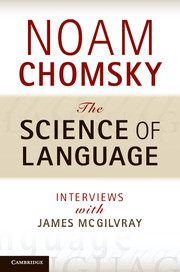Book contents
- Frontmatter
- Contents
- Introduction
- Part I The science of language and mind
- 1 Language, function, communication: language and the use of language
- 2 On a formal theory of language and its accommodation to biology; the distinctive nature of human concepts
- 3 Representation and computation
- 4 More on human concepts
- 5 Reflections on the study of language
- 6 Parameters, canalization, innateness, Universal Grammar
- 7 Development, master/control genes, etc.
- 8 Perfection and design (interview 20 January 2009)
- 9 Universal Grammar and simplicity
- 10 On the intellectual ailments of some scientists
- 11 The place of language in the mind
- 12 Chomsky's intellectual contributions
- 13 Simplicity and its role in Chomsky's work
- 14 Chomsky and Nelson Goodman
- Part II Human nature and its study
- Appendices
- Commentaries
- Glossary
- Bibliography
- Index
14 - Chomsky and Nelson Goodman
from Part I - The science of language and mind
Published online by Cambridge University Press: 05 June 2012
- Frontmatter
- Contents
- Introduction
- Part I The science of language and mind
- 1 Language, function, communication: language and the use of language
- 2 On a formal theory of language and its accommodation to biology; the distinctive nature of human concepts
- 3 Representation and computation
- 4 More on human concepts
- 5 Reflections on the study of language
- 6 Parameters, canalization, innateness, Universal Grammar
- 7 Development, master/control genes, etc.
- 8 Perfection and design (interview 20 January 2009)
- 9 Universal Grammar and simplicity
- 10 On the intellectual ailments of some scientists
- 11 The place of language in the mind
- 12 Chomsky's intellectual contributions
- 13 Simplicity and its role in Chomsky's work
- 14 Chomsky and Nelson Goodman
- Part II Human nature and its study
- Appendices
- Commentaries
- Glossary
- Bibliography
- Index
Summary
JM: Can we talk about Nelson Goodman for a while? Your relationship to him as an undergraduate and after is not often documented, while your relationship to Zellig Harris is, in several places, although not always accurately. But as for Goodman: there's not much discussion of what you got from him and what you think is valuable in his work. He was your teacher at Penn. He . . .
NC: We stayed quite close for many years later.
JM: And you must have been his protégé; certainly he must have gone to considerable effort to ensure that you got the position as a Harvard Junior Fellow, which made a very big difference in your life. I know that there are important philosophical differences between you, but there are also respects in which, it seems to me, you owe a debt to him. His conception of constructional systems, for example . . . What about your conception of simplicity – is that in any way owed to Goodman?
NC: My interest in it was certainly stimulated by his work. And you'll see the occasional footnote in his writings where we talked about . . .
I met Goodman when I was about 17 or so. I had never had any background in philosophy and I started taking his graduate courses with people who had a serious background, and he was very accommodating and helpful, and he didn't consider it inappropriate in any way that I didn't know anything. He'd direct me to read things, and the like. He was teaching at the time what became the Structure of Appearance, and the later courses that I took with him were teaching what became Fact, Fiction, and Forecast. What struck me particularly was that, whether you agreed with his conclusions or not, whatever he was doing was pursued with absolute intellectual integrity – and that's unusual, and striking. And it was worth pursuing in detail, even if you didn't agree, because you were witnessing a serious mind at work, taking what he's doing very, very seriously, pursuing the difficulties – trying to find the difficulties, and seeing if he could overcome them – all of it clearly on issues of very considerable significance. And he had a very ambitious project – more so, I think, than my interpretation of it at first. The Structure of Appearance was supposed to be a preliminary study to the Structure of Reality – and, of course, that never came. It got sidetracked into Fact, Fiction, and Forecast.
- Type
- Chapter
- Information
- The Science of LanguageInterviews with James McGilvray, pp. 86 - 92Publisher: Cambridge University PressPrint publication year: 2012

